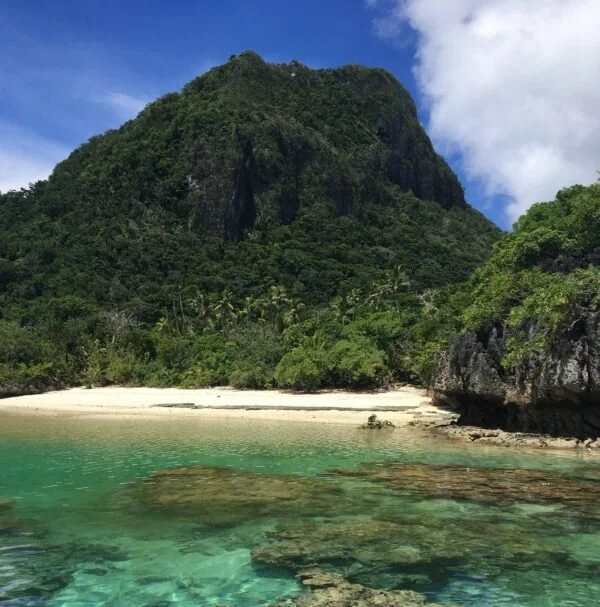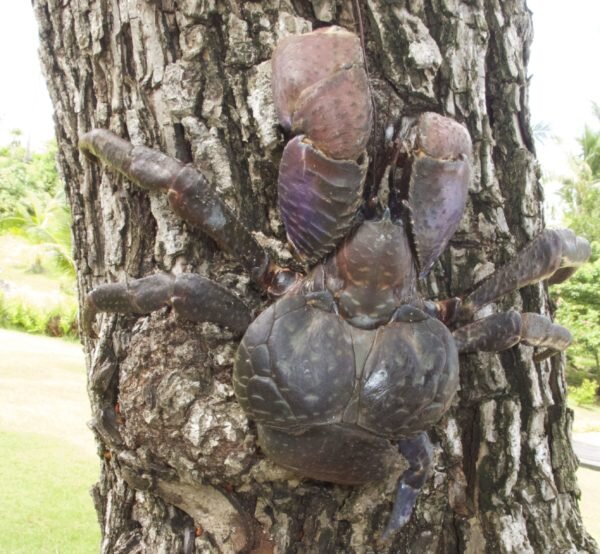Vatuvara Island: A Haven for Threatened Species
Clear lagoon and limestone summit of Vatuvara Island. Photo © Katy Miller.
Many of the islands we have explored in northern Lau remain much as they were during the days of Captain Cook’s early exploration – untouched and unparalleled in beauty.
Originally, the islands of the Lau Group were formed from a volcanic island arc along the Lau Ridge. Around 5.5 million years ago the active volcanoes that formed the islands underwent a period of subsidence and the Lau Ridge became covered by shallow water reef limestone. The geology of these islands now comprises both volcanic and reef-limestone rock.
Vatuvara is an unspoiled paradise ‒ a 1200-acre privately-owned island covered in overgrown forest over karst limestone, with a prominent vertical summit. The research team had been anticipating surveying this uninhabited jewel. After a sunrise start to cross 18 km of open water, the dive boat floated in azure waters over Vatuvara’s surrounding fringing reef. We were in awe of the vast limestone island, with the coral sand beaches sparkling under the sun – a set straight out of a Hollywood movie!
Vast limestone island. Photo ©Katy Miller.
Underwater, the team surveyed complex coral reefs with a variety of habitats ‒ from shallow exposed reef crests and reef flat communities to forereef drop-off zones with spur and groove ridge structures supporting a range of corals, diverse fish, and invertebrate species.
The island supported healthy populations of several globally threatened species, including the humphead, or Maori, wrasse (Cheilinus undulatus), which is classified as Endangered on the IUCN Red List, and vulnerable giant clams (Tridacna species). Humphead wrasses at Vatuvara Island were not disturbed by the presence of divers in the water, suggesting this species has not been exposed to constant fishing pressure (especially spearfishing), unlike other parts of Fiji where fish can be wary and flighty.
Vatuvara Island also has a large, unique, and prehistoric looking land crab that rules this island. Coconut ‒ or “robber” ‒ crabs (Birgus latro) can be found roaming the forest floor searching for dropped coconuts, which they crack open with their powerful pincers to feed upon. Coconuts crabs are the largest land arthropods and are indigenous to a few islands in the Pacific and Indian Ocean. Although small in populations, the species is listed as Data Deficient on the IUCN Red List, with no regulations for a protected breeding season or harvesting size.
Vulnerable Coconut Crab (Birgus latro). Photo: ©Vatuvara Private Islands.
Coconut crabs are easily over-harvested, as commercial demand for local consumption is impacting their survival. These crabs reproduce from 5 years of age and are terrestrial except for when females lay their eggs in the ocean. The juveniles that survive make their way back to land after a month. Surveys of these land crabs are urgently needed to understand the state of stocks in Fiji and to ensure measures are in pace to protect this species.
Vatuvara Island is a critical area for both marine and terrestrial species. Vatuvara Private Islands and Vatuvara Foundation are working with communities on awareness of threatened species, marine management, and poaching surveillance within their traditional fishing grounds.



